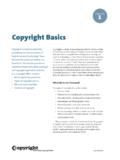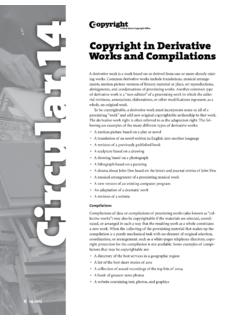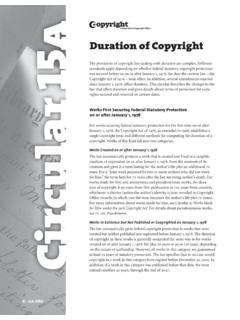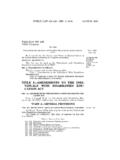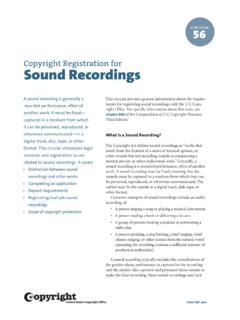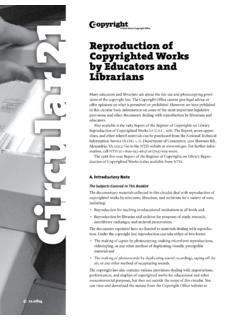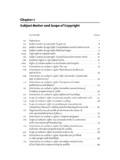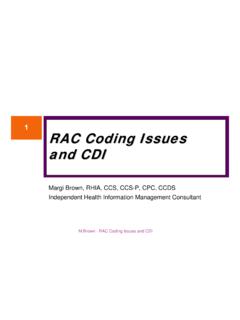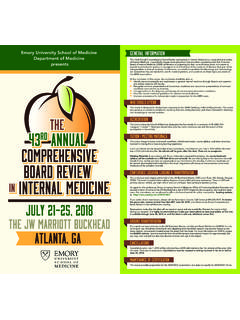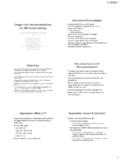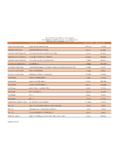Transcription of The Digital Millennium Copyright Act of 1998
1 Pub. L. No. 105-304, 112 Stat. 2860 (Oct. 28, 1998).1 Copyright Office SummaryDecember 1998 Page 1 THE Digital Millennium Copyright ACT OF Copyright Office SummaryDecember 1998 INTRODUCTIONThe Digital Millennium Copyright Act (DMCA) was signed into law by1 President Clinton on October 28, 1998. The legislation implements two 1996 WorldIntellectual Property Organization (WIPO) treaties: the WIPO Copyright Treaty andthe WIPO Performances and Phonograms Treaty. The DMCA also addresses anumber of other significant Copyright -related DMCA is divided into five titles: !Title I, the WIPO Copyright and Performances and PhonogramsTreaties Implementation Act of 1998, implements the WIPO treaties.!Title II, the Online Copyright Infringement Liability LimitationAct, creates limitations on the liability of online service providers forcopyright infringement when engaging in certain types of activities.
2 !Title III, the Computer Maintenance Competition AssuranceAct, creates an exemption for making a copy of a computer programby activating a computer for purposes of maintenance or repair.!Title IV contains six miscellaneous provisions, relating to thefunctions of the Copyright Office, distance education, the exceptionsin the Copyright Act for libraries and for making ephemeral recordings, webcasting of sound recordings on the Internet, and the applicabilityof collective bargaining agreement obligations in the case of transfersof rights in motion pictures.!Title V, the Vessel Hull Design Protection Act, creates a new formof protection for the design of vessel memorandum summarizes briefly each title of the DMCA. It providesmerely an overview of the law s provisions; for purposes of length and readability asignificant amount of detail has been omitted.
3 A complete understanding of anyprovision of the DMCA requires reference to the text of the legislation Digital Millennium Copyright Act of 1998 Copyright Office SummaryDecember 1998 Page 2 TITLE I: WIPO TREATY IMPLEMENTATIONT itle I implements the WIPO treaties. First, it makes certain technicalamendments to law, in order to provide appropriate references and links to thetreaties. Second, it creates two new prohibitions in Title 17 of the Code one oncircumvention of technological measures used by Copyright owners to protect theirworks and one on tampering with Copyright management information and adds civilremedies and criminal penalties for violating the prohibitions. In addition, Title Irequires the Copyright Office to perform two joint studies with the NationalTelecommunications and Information Administration of the Department ofCommerce (NTIA).
4 Technical AmendmentsNational EligibilityThe WIPO Copyright Treaty (WCT) and the WIPO Performances andPhonograms Treaty (WPPT) each require member countries to provide protection tocertain works from other member countries or created by nationals of other membercountries. That protection must be no less favorable than that accorded to 104 of the Copyright Act establishes the conditions of eligibility forprotection under law for works from other countries. Section 102(b) of theDMCA amends section 104 of the Copyright Act and adds new definitions to section101 of the Copyright Act in order to extend the protection of law to those worksrequired to be protected under the WCT and the of Copyright ProtectionBoth treaties require parties to protect preexisting works from other membercountries that have not fallen into the public domain in the country of origin throughthe expiry of the term of protection.
5 A similar obligation is contained in both theBerne Convention and the TRIPS Agreement. In 1995 this obligation was imple-mented in the Uruguay Round Agreements Act, creating a new section 104A in theCopyright Act to restore protection to works from Berne or WTO member countriesthat are still protected in the country of origin, but fell into the public domain in theUnited States in the past because of a failure to comply with formalities that thenexisted in law, or due to a lack of treaty relations. Section 102(c) of the DMCA amends section 104A to restore Copyright protection in the same circumstances toworks from WCT and WPPT member Digital Millennium Copyright Act of 1998 Copyright Office SummaryDecember 1998 Page 3 Registration as a Prerequisite to SuitThe remaining technical amendment relates to the prohibition in both treatiesagainst conditioning the exercise or enjoyment of rights on the fulfillment offormalities.
6 Section 411(a) of the Copyright Act requires claims to Copyright to beregistered with the Copyright Office before a lawsuit can be initiated by the copyrightowner, but exempts many foreign works in order to comply with existing treatyobligations under the Berne Convention. Section 102(d) of the DMCA amends section411(a) by broadening the exemption to cover all foreign Protection and Copyright Management SystemsEach of the WIPO treaties contains virtually identical language obligatingmember states to prevent circumvention of technological measures used to protectcopyrighted works, and to prevent tampering with the integrity of copyrightmanagement information. These obligations serve as technological adjuncts to theexclusive rights granted by Copyright law. They provide legal protection that theinternational Copyright community deemed critical to the safe and efficient exploitationof works on Digital of Technological Protection MeasuresGeneral approachArticle 11 of the WCT states:Contracting Parties shall provide adequate legal protec-tion and effective legal remedies against the circumven-tion of effective technological measures that are usedby authors in connection with the exercise of theirrights under this Treaty or the Berne Convention andthat restrict acts, in respect of their works, which arenot authorized by the authors concerned or permittedby 18 of the WPPT contains nearly identical language.
7 Section 103 of the DMCA adds a new chapter 12 to Title 17 of the section 1201 implements the obligation to provide adequate and effectiveprotection against circumvention of technological measures used by Copyright ownersto protect their 1201 divides technological measures into two categories: measures thatprevent unauthorized access to a copyrighted work and measures that preventThe Digital Millennium Copyright Act of 1998 Copying is used in this context as a short-hand for the exercise of any of the exclus-2ive rights of an author under section 106 of the Copyright Act. Consequently, a technologicalmeasure that prevents unauthorized distribution or public performance of a work would fallin this second Office SummaryDecember 1998 Page 4unauthorized copying of a copyrighted work. Making or selling devices or services that2are used to circumvent either category of technological measure is prohibited in certaincircumstances, described below.
8 As to the act of circumvention in itself, the provisionprohibits circumventing the first category of technological measures, but not distinction was employed to assure that the public will have the continuedability to make fair use of copyrighted works. Since copying of a work may be a fair useunder appropriate circumstances, section 1201 does not prohibit the act of circumvent-ing a technological measure that prevents copying. By contrast, since the fair usedoctrine is not a defense to the act of gaining unauthorized access to a work, the act ofcircumventing a technological measure in order to gain access is 1201 proscribes devices or services that fall within any one of thefollowing three categories:!they are primarily designed or produced to circumvent;!they have only limited commercially significant purpose or use otherthan to circumvent; or!
9 They are marketed for use in circumventing. No mandateSection 1201 contains language clarifying that the prohibition on circumventiondevices does not require manufacturers of consumer electronics, telecommunicationsor computing equipment to design their products affirmatively to respond to anyparticular technological measure. (Section 1201(c)(3)). Despite this general nomandate rule, section 1201(k) does mandate an affirmative response for one particulartype of technology: within 18 months of enactment, all analog videocassette recordersmust be designed to conform to certain defined technologies, commonly known asMacrovision, currently in use for preventing unauthorized copying of analogvideocassettes and certain analog signals. The provision prohibits rightholders fromapplying these specified technologies to free television and basic and extended basic tiercable Digital Millennium Copyright Act of 1998 Copyright Office SummaryDecember 1998 Page 5 Savings clausesSection 1201 contains two general savings clauses.
10 First, section 1201(c)(1)states that nothing in section 1201 affects rights, remedies, limitations or defenses tocopyright infringement, including fair use. Second, section 1201(c)(2) states thatnothing in section 1201 enlarges or diminishes vicarious or contributory copyrightinfringement. ExceptionsFinally, the prohibitions contained in section 1201 are subject to a number ofexceptions. One is an exception to the operation of the entire section, for lawenforcement, intelligence and other governmental activities. (Section 1201(e)). Theothers relate to section 1201(a), the provision dealing with the category of technologicalmeasures that control access to broadest of these exceptions, section 1201(a)(1)(B)-(E), establishes anongoing administrative rule-making proceeding to evaluate the impact of theprohibition against the act of circumventing such access-control measures.
